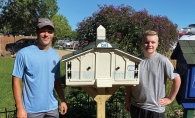The Girl Scout Gold Award is the highest honor a scout can achieve. Initiated in 1916, it recognizes the completion of a project that betters a Girl Scout’s community as well as the world at large. Four of our intrepid young lasses earned this distinction last spring; we caught up with them to hear about their projects and find out what else makes them tick.
Sarah Corniea is now a senior at Minnetonka High School. As a junior, she worked with city officials and volunteers to buy and install a sight-seeing binocular viewer and permanent display board with information related to the animal and plant life in Purgatory Park. “I wanted to do a project in that park because I had been there many times and really love it,” she says. “The park has a valley at its center with indigenous wildlife, and I wanted to have something there that people could use.”
What challenges did you face?
The two major unexpected challenges I met during my project were the fundraising and planning for the installation. I had raised about $200 less than I needed, but I was able to use some of the money raised from an art fair. I thought that I was going to have to dig a 4-foot by 4.5-foot hole and would need 60 bags of cement, but the people at the City of Minnetonka found an easier way to do it with rebar reinforcements.
What was most rewarding?
When I was presenting my project to the City Council, one or two of the council members told me that they had seen my project in the park and how their kids enjoyed using it.
Carolyn Francis is a 2013 graduate of Hopkins High School. Her Gold Award project, which she completed as a junior, addressed healthy eating among the homeless. She painted an educational mural of USDA's “My Plate” with residents at People Serving People, a homeless shelter in downtown Minneapolis. “I had always driven by People Serving People when I went downtown, so I was curious about it and wanted to do something involving their organization,” she says.
What was your biggest takeaway?
I learned the importance of organization. I had a binder where I kept every single receipt, note and bit of advice I received, as well as a detailed timeline of how to complete the work. That organization proved to be very useful when it came to organizing other things, such as schoolwork.
How have you changed as a result of the project?
Even the smallest things make a difference when it comes to pursuing a cause. I couldn't have just decided to eliminate homelessness in Minneapolis for my project, but by focusing my energy on a certain topic, the effectiveness of my actions was magnified.
Lisa Persson, who also graduated from Hopkins last spring, is a volunteer with the myHealth for Teens and Young Adults (formerly West Suburban Teen Clinic) advisory board. During her junior year, she chose to help spread awareness about the no-cost health services the clinic offers to youth ages 12 to 23, including basic medical care, reproductive health care and mental health counseling on a pay-what-you-can basis. “We hosted an open house at the clinic and gave informational tours to over 200 guests,” Lisa says. “Each guest got a chance to meet some of the staff, see the clinic, learn more in depth about the expansive range of services offered and eat an ice cream sundae at the end. “
What did you learn?
I learned how to ask for donations and not be afraid to put myself out there while managing a project. We put in several “asks” to local businesses, and I was surprised and relieved at how much support we received. I also learned the effectiveness of asking for something in person rather than asking via email. All of the most effective communication that moved my project forward happened face-to-face.
Did you meet any unexpected challenges?
One difficult aspect was organizing specific tasks for each person to do. I had to split up the work between about eight people, and then follow up to make sure everyone was on track. It was the first time I had managed anything on a large scale, so I was not prepared when a few things fell through.
Natalie Polinsky, another 2013 Hopkins graduate, organized a garden club for children at a local daycare center to educate them about healthy eating to prevent childhood obesity during her junior and part of her senior years. “During the time that we met, the girls planted and watered our garden, we learned about what plants need to grow, made new recipes with the produce from our garden and learned about how a garden can benefit both our health and our environment,” she says.
What was the most rewarding part?
The most rewarding part was seeing how much fun the kids had visiting the farmers market in Minneapolis, watering their plants and doing the different activities with me.
Was there anything that surprised you?
The most surprising was how much the kids absorbed the information after they started to focus, and how interested they were.









